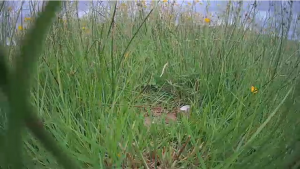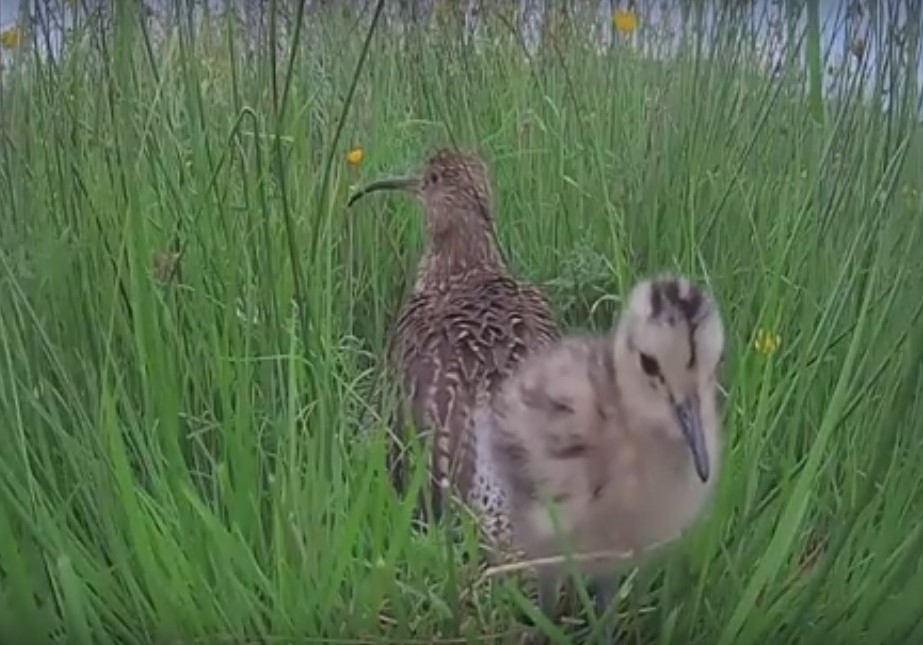Blog by Amanda Perkins, Curlew Country Project Manager
 Thank you to the many people who have sent positive messages about the Curlew Cam. Unlike tree nesting birds observed by a camera, the natural departure of curlew chicks from the nest is much more abrupt and has left viewers wanting to see more of what happens to them next. We left the camera running in case the birds returned to the nest occasionally, but there was mainly an empty nest cup. The team are pleased with the interventions, based on findings from the first two years, that have enabled eggs to hatch into chicks, but now need to discover what is happening to the chicks.
Thank you to the many people who have sent positive messages about the Curlew Cam. Unlike tree nesting birds observed by a camera, the natural departure of curlew chicks from the nest is much more abrupt and has left viewers wanting to see more of what happens to them next. We left the camera running in case the birds returned to the nest occasionally, but there was mainly an empty nest cup. The team are pleased with the interventions, based on findings from the first two years, that have enabled eggs to hatch into chicks, but now need to discover what is happening to the chicks.
We are not entirely sure why curlew leave the nest site so quickly, but suspect it is due to a number of factors. Firstly a nest will provide evidence to predators of the whereabouts of potential prey. Secondly, the chicks are never fed by the parents, but need to start feeding on insects quickly to survive. If the surrounding habitat is not rich in invertebrates, the chicks and parents need to move to a more suitable feeding area. We have also noticed that chicks struggle to move through dense grassland, but also need a sufficient length and abundance of sward to hide from predators.
The empty nest cup reflects the stage of the Curlew Country project – we have succeeded in enabling chicks to hatch, but now need to know a great deal more about the chicks and their fate to learn how we can help them. Our chicks, whose fate was un-known are Champions for their species, helping us to learn more about what can be done to secure future generations of curlew.
 The chick tagging took place early in the morning. When I arrived at the farmer’s house some way away, but in sight and sound of the nest, I could hear the curlew adults alarm calling and obviously rather agitated. Amber one of the team could hear this on Curlew Cam and telephoned to tell us she was concerned. We had been watching Curlew Cam closely trying to get there as soon as they looked about to leave the nest. Tony Cross, the ornithologist, had judged correctly that it would be early on Wednesday morning. As Tony and I approached the nest site, we
The chick tagging took place early in the morning. When I arrived at the farmer’s house some way away, but in sight and sound of the nest, I could hear the curlew adults alarm calling and obviously rather agitated. Amber one of the team could hear this on Curlew Cam and telephoned to tell us she was concerned. We had been watching Curlew Cam closely trying to get there as soon as they looked about to leave the nest. Tony Cross, the ornithologist, had judged correctly that it would be early on Wednesday morning. As Tony and I approached the nest site, we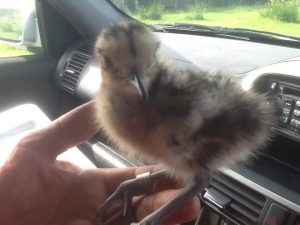 could see a number of crows sitting overlooking the nest site. Our concern then grew as we could only find one of the chicks. With patience they were all located, colour ringed, tagged, and safely returned to where they were found. We then watched the adult curlew return to them from a distance and left them. This was all done as quickly as possible to minimise disturbance, but I confess to some bad language from both Tony and I in our anxiety that the chicks may have been lost moments before we arrived, when we were struggling to locate them.
could see a number of crows sitting overlooking the nest site. Our concern then grew as we could only find one of the chicks. With patience they were all located, colour ringed, tagged, and safely returned to where they were found. We then watched the adult curlew return to them from a distance and left them. This was all done as quickly as possible to minimise disturbance, but I confess to some bad language from both Tony and I in our anxiety that the chicks may have been lost moments before we arrived, when we were struggling to locate them.
Tony went to get some breakfast. I went to see Chris New of Secure Web  Services (SWS) who has been helping us by providing the live streaming of the Curlew Cam and on this occasion helped with a temporary repair to the transmitter that we use to track the radio tagged chicks. I had hoped for his advice on where to go to get the repair, but instead Chris leapt to the challenge. Chris is one of a number of businesses or individuals supporting Curlew Country as much as they can. Rappa fencing helped with more precise design and gave us a generous discount on the curlew enclosure electric fencing. A lady called Sue has designed wonderful seasonal curlew themed cards and gives the proceeds to the project. They are all examples of Curlew Champions.
Services (SWS) who has been helping us by providing the live streaming of the Curlew Cam and on this occasion helped with a temporary repair to the transmitter that we use to track the radio tagged chicks. I had hoped for his advice on where to go to get the repair, but instead Chris leapt to the challenge. Chris is one of a number of businesses or individuals supporting Curlew Country as much as they can. Rappa fencing helped with more precise design and gave us a generous discount on the curlew enclosure electric fencing. A lady called Sue has designed wonderful seasonal curlew themed cards and gives the proceeds to the project. They are all examples of Curlew Champions.

Next stop was a farmer and then a contractor to make sure that they had got the message about a meeting that evening, then onto the Bridges pub car park to meet with Curlew Champions Mary Colwell Hector, Phil Sheldrake and Mike Smart who along with Dr. Geoff Hilton, chief scientist at the Wildfowl and Wetlands Trust, Slimbridge, organised the ‘Call of the Curlew’ Symposium at Slimbridge to galvanise action to help save the UK curlew population outside moorland and upland reserve areas.
The team of three had come to visit the project to look at our nest monitoring at chick stage. Mary and Mike had both visited Curlew Country before (as had Geoff Hilton), but Phil had not. Mary Colwell, through her 500 mile walk across Ireland and the UK has been a fantastic advocate for curlew everywhere, but particularly outside moorland and upland areas, where there are comparatively few initiatives and resources to reverse population decline.
Phil is the RSPB Conservation Officer for Wiltshire & Gloucestershire, and monitors curlew on Salisbury Plain. Mike has worked on RAMSAR sites around the world and now retired, similarly works with farmers on a voluntary basis to monitor curlew nests in Worcestershire and Gloucestershire. Please see Mary Colwell Hector’s blog here and Mike Smart’s blog from a previous visit here. The Slimbridge Group are forming an information forum to exchange news, findings and best practice for curlew projects.
After the usual decisions on priorities, Mary, Phil and Mike departed to track curlew chicks with Tony and I left to do some crucial admin, including apologising to BBC Radio Shropshire as we had missed an interview slot at the crucial tagging moment and very importantly to re-fill various flasks for Tony.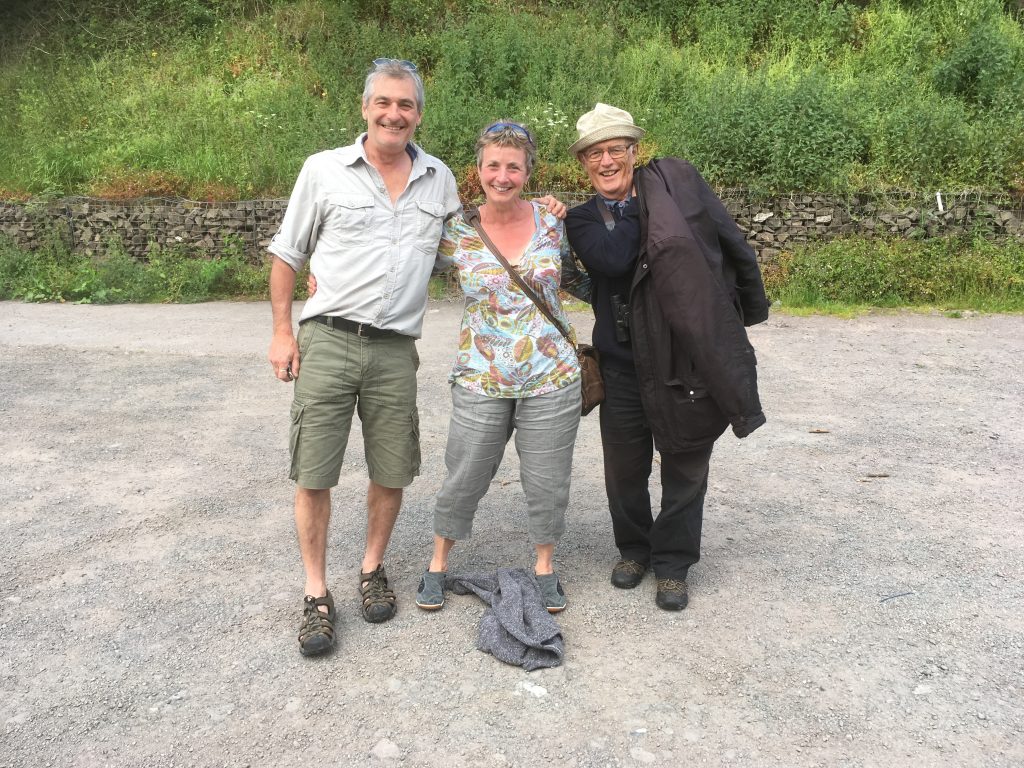
When I re-joined the others they had found the approximate location of the birds, but not tracked them with the transmitter. In the small rushy patch that the curlew chicks had chosen to occupy it was hard to find them, although the peeping signals from the transmitter seemed like re-assuring heart beats. These chicks had crossed a large expanse of grassland soon to be harvested, in search of an area richer in the invertebrate food and damp ground that they need. The sward had a high ryegrass density typical of modern agricultural grassland. In other denser ryegrass dominated sward we suspect that it becomes more difficult for the chicks to move about.
Tracking the chicks had taken several hours and for our visitors who had undertaken long journeys it was time for lunch. Mike Smart who had previously commented on his appreciation of the 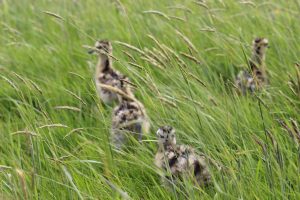 hearty ploughman’s lunch (see Mike’s blog here) at the Bridges pub was observing Ramadan, so in sympathy we were not so hearty in our appetites as we might otherwise have been. Sitting outside the pub, we were spotted by Roger Owen, formerly of Natural England, Mercia Region and another local Curlew Champion. During his tenure at the head of the local NE region Roger fought hard to raise awareness of the plight of curlew and obtain funding for a curlew project. At the beginning of the Curlew Country project in 2015 he fought to secure funding from the NE Species Recovery fund, but lost the battle to a much larger NGO running a project in the moorland and upland, which is where NE were targeting their funding. Although retired and ‘off-duty’ walking with his wife Sally and their dog, Roger could not resist asking for an update of the project and the Slimbridge three then asked questions about NE’s role in curlew recovery initiatives and particularly in relation to funding.
hearty ploughman’s lunch (see Mike’s blog here) at the Bridges pub was observing Ramadan, so in sympathy we were not so hearty in our appetites as we might otherwise have been. Sitting outside the pub, we were spotted by Roger Owen, formerly of Natural England, Mercia Region and another local Curlew Champion. During his tenure at the head of the local NE region Roger fought hard to raise awareness of the plight of curlew and obtain funding for a curlew project. At the beginning of the Curlew Country project in 2015 he fought to secure funding from the NE Species Recovery fund, but lost the battle to a much larger NGO running a project in the moorland and upland, which is where NE were targeting their funding. Although retired and ‘off-duty’ walking with his wife Sally and their dog, Roger could not resist asking for an update of the project and the Slimbridge three then asked questions about NE’s role in curlew recovery initiatives and particularly in relation to funding.
Roger and Sally escaped and Tony departed to other ornithological duties. I took the ‘Slimbridge three’ on a quick tour of the remainder of the Curlew Country area to demonstrate the 2017 success of intervention to get nests past egg stage to hatching, and the problems that we have discovered that our local birds encounter. We visited a nest site where eggs were due to hatch and then checked on another only to find that it had been lost to predation. It was hard to tell the culprit from the signs. Phil found a tiny fragment of egg shell on grass, but there were no obvious clues. It is possible that the fence had shorted out as the grass at the base of the fence, which is usually tightly cut to the ground by strimming, had grown very quickly, although the power was still working when I tested it.
Foxes usually remove entire eggs and do not create a very obvious track to the nest. Badgers flatten the grass around the nest and eat the eggs on site, leaving large pieces of shell and obvious tracks to the nest. Crows also usually eat eggs in situ leaving bits of shell. The evidence gave us few clues, but one of the Curlew Country team had previously expressed concern about large flocks of ravens in close proximity to the nest that the curlew parents were often trying to fend off, so ravens were another possible predator. Sometimes there is a combination of factors that it is hard to analyse, particularly when birds are frightened off the nests for long periods.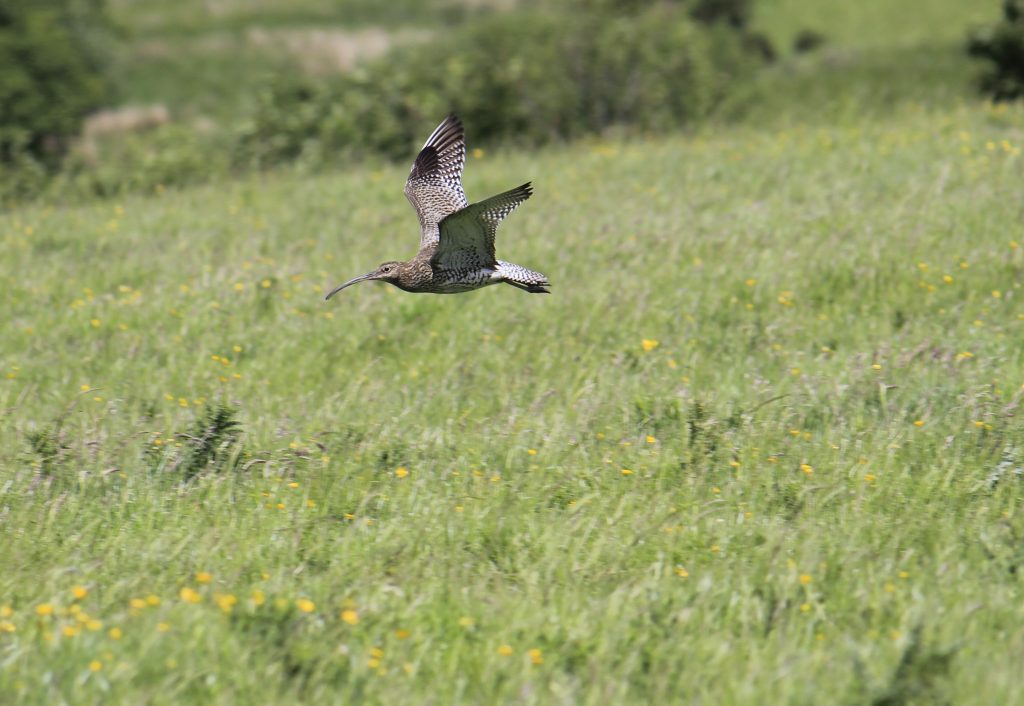
At one farm we saw a site where an accident had led to the loss of newly hatched curlew chicks, most probably to agricultural activities. Knowledge of this is shocking and at first it can seem careless of a farmer to have let this happen, but I have never met a land manager willing to harm this iconic wader species with which they feel a strong connection. Farmers have become Curlew Champions working with the project to do as much as they are able to help birds breed successfully on their land. We cannot ask a farmer to stop farming a number of fields if we cannot find the eggs or the chicks, nor could they afford to do so.
During the nesting season, it can be difficult to remain positive when nest after nest fails and hope for any survival of chicks is diminished, although this is tempered by a level of endurance based on experience. Farmers feel responsible for ‘their’ chicks and are disappointed or unhappy when nests are lost to causes that they cannot influence or control. The loss of chicks had saddened everyone involved in this case and was probably due to contractors turning up earlier than expected.
One of the nests we had visited was in a field that had been intended to be grazed by cattle. The farmer hoping that the birds, even in their fenced enclosure would be less disturbed, had changed his plans to help the birds. Another nest site that we visited had been located by a Community Wildlife Group bird surveyor. For two years this volunteer has given up time to find the nest, cultivated a good working relationship with the farmer whose land it is upon and this has been most helpful to the Curlew Country Project. Two more Curlew Champions doing their best to help these birds.
The Slimbridge ‘Call of the Curlew’ team are aware of the problems but less used to regular confrontation with nest failure were possibly a little dispirited by witnessing the challenges illustrated during the afternoon visit. It was a good day with lots of discussion and thought about what can be done to try and save curlew, not just in Shropshire, but throughout the UK. They set off on long car journeys home probably with even more to ponder upon. I whizzed home before coming out to the evening meeting with a farmer and contractors.